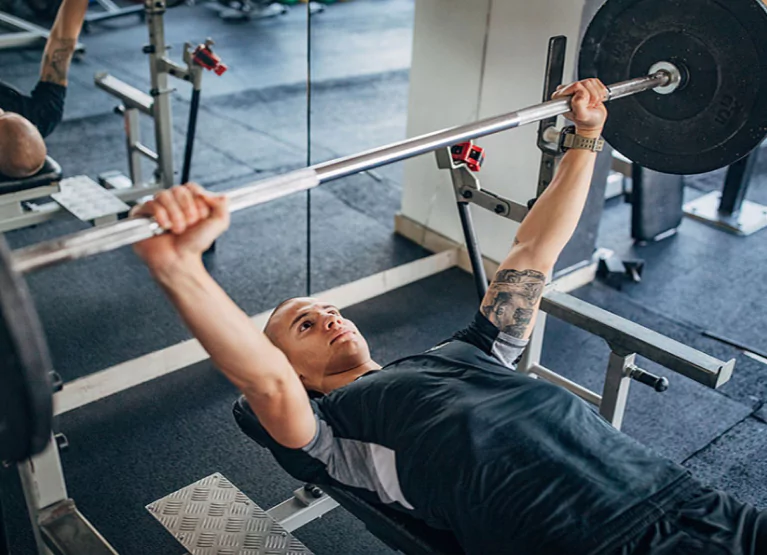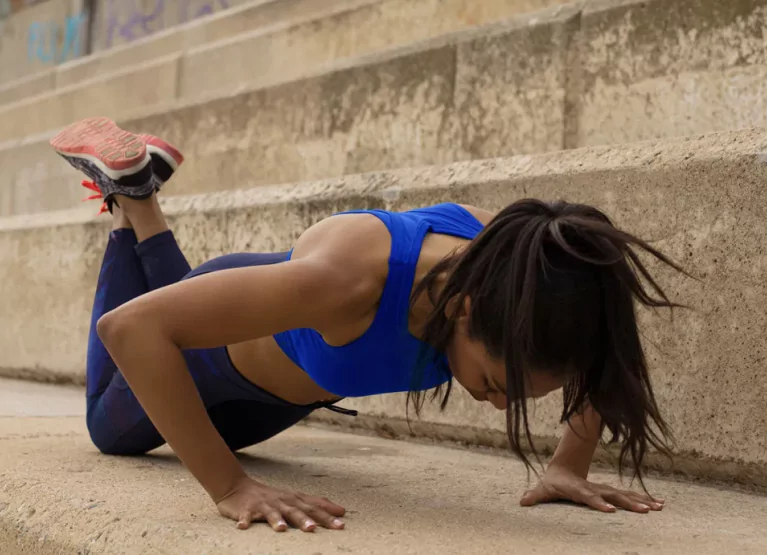The Best Chest and Shoulder Workouts for Beginners
.webp)
Key Takeways
If you’re new at the gym or have just started your weight loss journey, jumping into weight-based exercises can feel daunting. There are so many different machines, movements, and techniques out there, and figuring out where to start can be tough.
However, weight training has a wide range of health benefits, from helping increase muscle mass to increasing your metabolic rate. And the good news is that starting small can still make a positive difference.
For anyone lifting weights for the first time, understanding the basics of how to strengthen each of the main muscle groups is a great place to start. In this article, we’ll take you through some of the best chest and shoulder exercises for beginners and share a helpful upper body training plan to try out during your next gym session!
The Benefits of Muscle Building
You’ve probably heard fitness coaches talk about the benefits of cardio exercise when it comes to weight loss. However, recent research has demonstrated the positive impact that strength training can have on burning fat. Increasing your muscle mass has also been linked to a reduced risk of type 2 diabetes, better cardiovascular health, and lower resting blood pressure.
In addition to all these benefits, muscle building through strength training can also have the following benefits:
- Increase insulin sensitivity
- Increase bone density
- Lower your risk of injury
- Can improve your physical self-concept, or how you view your physical fitness, body, and self-esteem
- Can boost cognitive function
- Can increase levels of HDL cholesterol
Why You Should Care About Strengthening Your Chest and Shoulders

While it’s important to focus on doing exercises for each muscle group, this article will focus primarily on exercises for the upper body. Strengthening your chest and shoulders can be beneficial for more than just aesthetic reasons.
Here are some of the benefits of working out your upper body through strengthening exercises.
Can Improve Shoulder Function
In one study looking at military helicopter pilots, performing lifts targeting the shoulders was observed to improve shoulder functions and even increase the subjects’ range of motion. Having stronger shoulders may also help support other areas of the upper body such as the neck.
Can Help Support a Healthy Posture
Research has shown that muscle imbalances or issues such as rounded shoulders can lead to poor posture. By performing muscle-building movements that target the shoulders, chest, and spine, you may be able to improve these kinds of issues. Strong shoulders can contribute to an improved posture that supports the rest of the body.
May Help Respiration
Chest exercises, as well as core exercises, may help support specific parts of the respiration process. This is because some chest muscles (and muscles located in the abdominal area) are involved in respiration.
Four Best Chest and Shoulder Exercises for Beginners
If you’re a beginner, you’ll want to start off with simpler exercises and light weights when you first go to the gym. Using your body weight, free weights or even resistance bands can all be good ways to dip your toes into the process while still seeing results and learning proper form.
Remember that to get the most benefit, you will likely want to incorporate upper body exercises into a workout plan or regime that targets the whole body. This can help you make sure you’re not neglecting your other muscle groups as you work on your upper body strength.
Here are four of our favorite beginner-friendly exercises for strengthening your chest and shoulders. Always consult with your medical provider before starting a new exercise routine or program.
Shoulder Press

The shoulder press is one of the easiest exercises to begin with. It can also be combined with another exercise, such as a squat to press movement, if you’re aiming to get more compound movements in.
This movement involves using weights, either using dumbbells or a barbell and pressing them over your head to strengthen your deltoid muscles. You can do this movement while seated at an upright bench or while standing.
Here’s how to perform a shoulder press:
- Start by sitting upright with a straight spine. You can also stand up for this exercise, and you’ll also want to keep your back straight, spine neutral, and feet hip-width apart.
- Hold the weights at shoulder height with your arms at a perpendicular angle.
- Press the weights up and keep your elbows at a 45 degree angle as you fully extend your arms. As you do this, make sure to keep your core stable and feet planted firmly on the ground.
To get the most out of this exercise, focus on building the mind-muscle connection by focusing the movement in your shoulders. Remember to do this movement slowly, and pace yourself through the exercise.
Chest Press

The chest press movement is quite similar to the shoulder press, but mainly targets the pectoral muscles in your chest. It also works shoulder muscles such as the deltoid. This movement can be conducted with a chest press machine, with dumbbells, or even with a barbell if you want to perform the traditional bench press.
You can also increase the angle of your bench to perform an incline chest press. This will target the upper chest as well as the tricep and deltoid muscles.
To perform a chest press, you’ll want to:
- Get into position by lying on your back with your feet on the ground while positioning your dumbbells straight overhead.
- Hold the weights in your arms and slowly lower them to your chest while keeping your elbows at a 45 degree angle.
- Press the weights back into your starting position by pushing the weights up, and then repeat by lowering them back down again.
To get the most out of this exercise, focus on squeezing your shoulder blades and pushing through your chest to get the dumbbells back up to your starting position.
Plank

Believe it or not, the plank is another effective exercise for the shoulders. Although this exercise primarily targets your core, it also works the whole upper body due to the position held while performing the movement.
What makes planks so great for beginners is that it’s a bodyweight exercise and requires no equipment. If you want to make this exercise more challenging, you can try lifting one leg up while holding the position.
To do this exercise, you’ll want to grab a mat and then:
- Lay down on the mat with your elbows planted firmly into the mat and your fists clenched.
- Fully extend your body and place your feet on the opposite end of the mat, making sure to curl your toes inward.
- Push your body up, making sure to squeeze your core and keep your back flat and in neutral position.
- Hold for 30 seconds or more then slowly lower your body back down.
For this exercise, focus on tightening your core throughout the movement to keep your back in the correct position. It’s also important to ensure you don't dip your back or push your hips too far upward.
Beginner Push Ups

Push ups are a great bodyweight exercise that can be easily modified for beginners. This exercise works out a variety of muscle groups in the upper and lower body, but is especially helpful in increasing muscle mass in the triceps, shoulders and pectoral muscles.To make it more beginner friendly, you can:
- Place your knees on the mat with your palms planted firmly. Your arms should be shoulder width apart and at shoulder height. Your elbows should be slightly tucked in at a 45 degree angle (not flaring completely outwards).
- “Push” your body downwards by lowering yourself slowly and bending your elbows as you do so. Once your chest taps the ground, push yourself back into your starting position.
- Make sure to perform this movement slowly, focusing on the tension in your chest and arms.
If this modification already sounds daunting, you can make use of a resistance band to make it even easier. Simply place the resistance band around the outside of both your arms before getting into position. When doing your push-ups, the resistance band will help support your body weight and make it easier to push yourself back up.
Sample Training Plan
Now that you have some exercise ideas in mind to help you get started in the gym, here’s a sample training plan for your next upper body workout.
This plan focuses on shoulder and chest movements, but also targets other areas of the arms. As always, be sure to consult a medical provider before beginning a new workout regimen if you are someone who may have a higher risk of injury.
Warm Up
Complete 10 minutes of light cardio (on the treadmill, elliptical, or bike) to get your heart rate up.
Muscle Activation
Complete three rounds of the following exercises to activate your upper body muscles and prepare them for the workout:
- 10 band pull aparts
- 10 push up-to-planks
- 10 standing dumbbell shoulder rotations
Main Exercises
For the main portion of the workout, complete each set of exercises as follows. Start with the superset below, repeating three to four rounds with light dumbbells.
1) Dumbbell Bench Press — 10 reps
2) Lateral Dumbbell Raise — 10 reps
Once you finish, move onto three rounds of the next two exercises as follows:
1) Seated Dumbbell Shoulder Press — 8 to 10 reps
2) Overhead Tricep Extension — 10 reps
Finally, finish off with three rounds of the following exercises:
1) Knee Push Ups — 5 to 10reps
2) Alternating Hammer Curls — 10 per arm
3) Plank — 30 seconds
Once you’ve completed these exercises, you can finish off with a cool down on the treadmill, or even do a quick core routine. Remember to choose weights that suit your fitness level and take care to practice proper form to avoid any risk of injury.
Find the right Nutrisense programto turn insight into progress.
Go Beyond Glucose Data with Nutrisense
Your glucose can significantly impact how your body feels and functions. That’s why stable levels are an important factor in supporting overall wellbeing. But viewing glucose isn't enough. Nutrisense, you’ll be able to learn how to use your body's data to make informed lifestyle choices that support healthy living.
One-to-one coaching
Sign up to access insurance-covered video calls to work with a glucose expert: a personal registered dietitian or certified nutritionist who will help tailor your lifestyle and diet to your goals.
Monitor and measure what matters
With the Nutrisense CGM Program, you can monitor your glucose with health tech like glucose biosensors and continuous glucose monitor (CGM)s, and analyze the trends over time with the Nutrisense App. This will help you make the most informed choices about the foods you consume and their impact on your health.
Find your best fit
Ready to take the first step? Start with our quiz to find the right Nutrisense program to help you take control.

Heather is a Registered and Licensed Dietitian Nutritionist (RDN, LDN), subject matter expert, and technical writer, with a master's degree in nutrition science from Bastyr University. She has a specialty in neuroendocrinology and has been working in the field of nutrition—including nutrition research, education, medical writing, and clinical integrative and functional nutrition—for over 15 years.




